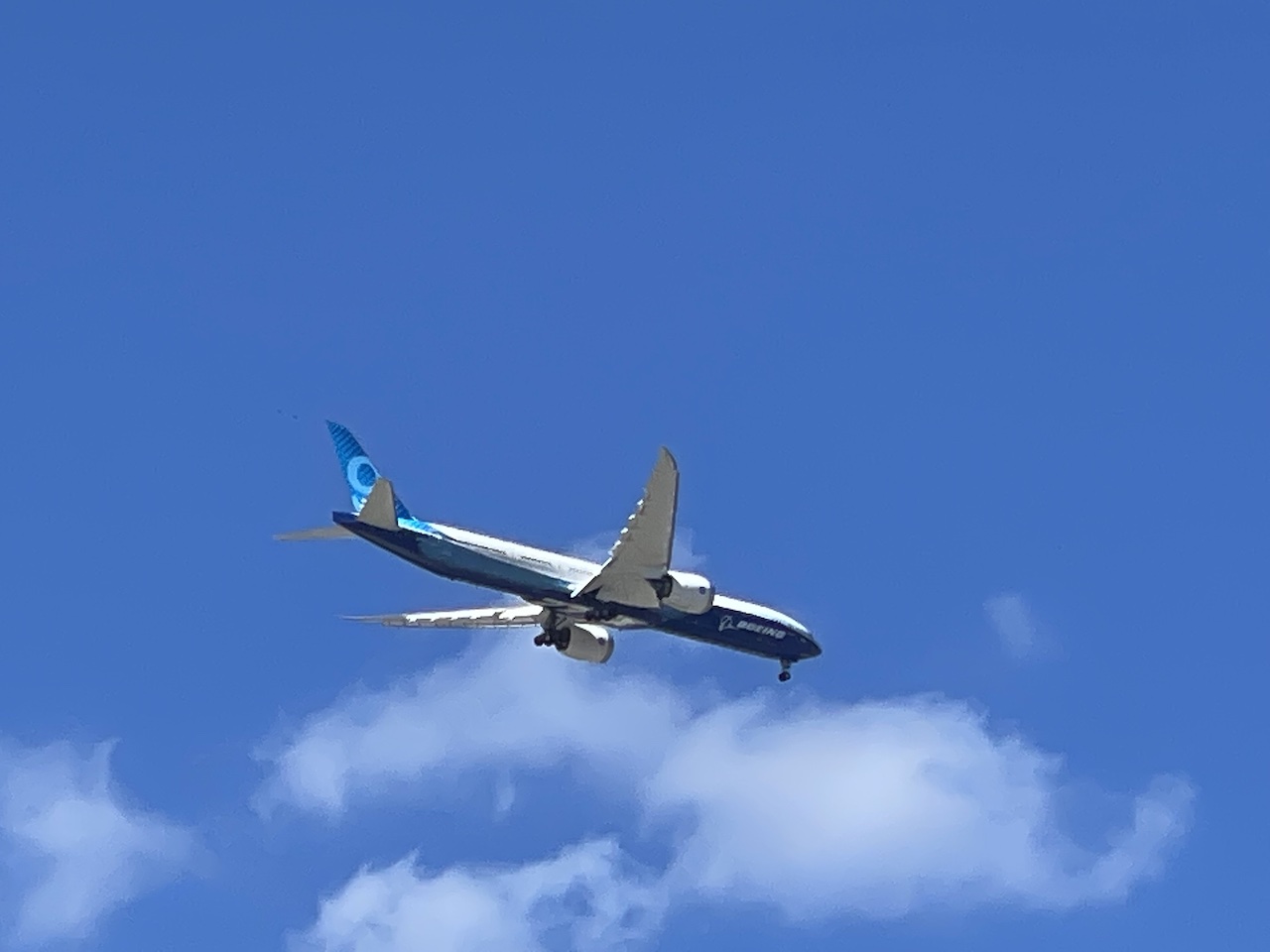Sales of Boeing’s updated 777X line have been serviceable for the 777-9, but one model isn’t selling well at all and it’s prompting a rethink about the airframe.
If you are considering booking travel or signing up for a new credit card please click here. Both support LiveAndLetsFly.com.
If you haven’t followed us on Facebook or Instagram, add us today.
The Boeing 777X
At the tender age of 11 I devoured all 368 pages of Twenty-First Century Jet: The Making and Marketing of the Boeing 777. This led to extreme popularity among my classmates as you might have suspected. It also fueled my already rabid passion for what was (and remains) a revolutionary aircraft.
The aircraft was launched almost 30 years ago and despite the success of the 787 Dreamliner (also revolutionary in and of itself), the widebody needed a refresh to fend off worthy competitors like the Airbus A350-1000.
To achieve increased fuel efficiency, the most important metric for any long-term operator of aircraft, Boeing had to enlist the help of a revision to its powerplant and an adjustment to the wing. The original GE90 engines were the world’s largest; the diameter of which was comparable to the fuselage of a 737. For the new version, General Electric produced a more efficient GE9x engine.
Additionally, Boeing built the largest ever wing, in fact, they are so large that they won’t fit in most airport terminals. Boeing revisited its initial plan for folding wingtips, a requirement by the original 777 launch customer, American Airlines, to then fit into gates accustomed to DC-10s.
The 777X line comes at an important crossroads for the wide-body market. Behemoths like Boeing’s own 747-8 and the Airbus A380 are less attractive than twin-engine jets but need to be replaced. The Airbus A350 and even the massive 777-300ER – a runaway success in the market – can’t supplant the volume of passengers and cargo of the larger jumbo jets. The new 777-9 can get far closer with excellent economics.
On a personal note, Boeing was testing the 777-9 in Fort Myers last year. I reached out to their team to secure some behind-the-scenes access purely for the edification of our readership, but Boeing politely declined my request. The below photo was as close as I got though I was subjected to the torture of watching that massive, beautiful aircraft on a slow approach every afternoon.

Boeing’s Order Book Stalls for 777-8
The majority of the orders to date have been for the 777-9 variant, comparable to the current version of the 777-300ER, and in time to backfill the replacement of the jumbo jets and to be ready for its first round of 777-300ER replacements. While the type has a substantial commitment in the form of more than 350 jets, the smaller version, the 777-8 hasn’t been as popular as its big brother for a few reasons. This video explains it well (I start the video following his sponsor commercial):
In short, the 777-8 may not do enough to justify an order. Its weight and size but lower seating capacity (close to 300 in a four-class configuration.) By not switching to a composite body style like the A350, or a lighter alloy, it’s less economical for the number of passengers it carries. However, some industry analysts would point to the stuggles Boeing had with its composite model, the 787 and suggest that it was a prudent decision to stay with a tried and true model.
Additionally, the concern about Maximum Take-off Weight (MTOW) could restrict the viability of the type.
Some orders that have been placed for the 777-8 are suspected to be converted to 777-9 orders, though of note the 777-8 appears to have a future as a cargo offering.
This is a new phenomenon as one variant tends to outshine another and customers follow one another’s lead. The 787-8 (424 orders) and 787-10 (190 orders) have been far less popular than the 787-9 (1,042 orders.) The 787-3 was developed and sold (43 orders) but abandoned with orders converted. The A350 has sold 967 units of which half have been for the A350-900.
It remains entirely possible that the 777-8 goes away altogether, or that customers will find a unique niche as other aircraft are moved out of service and markets evolve.
What This Could Mean For A 777-10
A stretch version that could replace the A380 and 747 models makes sense with a 777-10. It’s not yet been developed but according to engineers from Boeing, it would require minimal adjustments. However, in a four-class configuration, it is suggested that such an aircraft would fly around 450 passengers but at a far lower fuel burn when compared to the aircraft it would replace, most notably, the A380 at 500 passengers.
This is particularly helpful for slot-constrained airports like London Heathrow where investing in two slot pairs to replace one larger one (utilized by an A380 or 747) wouldn’t be economical but may also be impossible. For routes where demand exceeds the A350’s payload but not enough to offer a second widebody on the route, the 777-10 can offer more passengers and cargo in a way that Airbus can’t compete. Airbus shut down the A380 production line in September of 2020, the 747-8i shut down its production line this year.
The good news is that the current 777-9 appears to be on track. Production lines have restarted following a pause and the type is adhering to its modified 2025 delivery schedule. Boeing will need to put some planes into service before a 777-10 model can be considered seriously, but should the manufacturer opt to not produce the 777-8, conversions into -9 and -10 offerings could be possible.
I’d argue that the post-pandemic state of the A380 has made this even more likely. Many airlines retired their A380 fleet “permanently” during the pandemic but have put them back into service following an unexpectedly robust return to travel. Each one of those carriers would undoubtedly swap them for a twin engine that could serve nearly the same mission and payload. That creates opportunity and Boeing is in need of some opportunity.
Conclusion
Customers are not responding to the 777-8 in the same way they have done for the 777-9. It’s possible the 777-8 will be converted to a freight only option or will go away altogether. The successful order book the manufacturer has built and the market need for a jumbo jet replacement (as well as strong forward passenger demand) makes room for the 777-10 stretched variant, though official plans have yet to be confirmed.
What do you think?




Kyle writes “The majority of the orders to date have been for the 777-9 variant, comparable to the current version of the 777-300ER”
I am not sure this is true. The 777-8 is comparable to the 777-300ER. Actually, I believe that the…
777-8 is intermediate in passenger capacity between the 777-200 and 300. In terms of range, it is slightly beyond the 777-300ER and comparable to the 777-200LR.
777-9 is larger in passenger capacity than the 777-300ER. In terms of range, the 777-9 is comparable to the 777-300ER.
In other words, the 777-8 is a 777-200/300 hybrid in terms of passenger numbers with the longest range.
The 777-9 is even bigger than any 777 made and has a very long range but not the longest.
@Derek: There are a number of different sources for how many seats the aircraft can carry. However, from what I have confirmed with industry sources, the length of the aircraft are as follows:
• 777-200 – 209 ft in length
• 777-8 – 229 ft in length
• 777-300ER – 242 ft in length
• 777-9 – 251 ft in length
So we agree that the -8 is in between the 200/300ER, and that the -9 is the largest which is confirmed in what I wrote. I’d argue that the 300ER and -9 are just 9′ different (though no one disputes the -9 is bigger), while the -8 is 13′ smaller than the 300ER. You’re correct, they are a hydbird, but when I said that the -9 is comparable to the 300ER, I was simply saying that it was very large and closer in size whereas the -8 is 20′ bigger than the 200, a 9.5% increase rather than 3.7% increase from the 300ER. That feels more significant to me and more negligible in the latter case.
“This is a new phenomenon as one variant tends to outshine another and customers follow one another’s lead.”
It is? Do I need to list the variant examples that were a failure with virtually every other model ever produced? What am I missing here?
The smaller version of most jets fail to find an audience due to cost per mile of each PAX. The medium and larger version of a jet family have a lower unit cost due to more PAX to spread over per flight.
Examples include:
– Lockheed TriStar 500 which only carried 250 PAX while other version carried 300+ per trip. BA only held onto its 250 series for a few years before turning over the units to the British Royal Air Force.
– Boeing played with the idea of a B757-100 series. However, this over lapped the the B737 . Therefore, Boeing only developed the 200 & 300 series with more PAX per flight
– Airbus is have difficulty selling the 800 version of the A330 NEO. The 900 can carry 40 to 50 more PAX per flight.
– if extended range is needed, an ER version (Boeing); or LR or XLR version (Airbus) can be developed. The best selling version of the B767 was the 300-ER. It hit the sweet spot for Transatlantic routes.
@Paper Boarding Pass – That’s true in some cases, the A318 (Baby Bus) is a good example. But the 737-200, then later the 500, then still later the 700 were all extremely successful as the smallest in their iterations. The current focus of the A320 line does focus on the A321 side but that’s more down to a lack of replacement for 757s. The A380 was originally meant to have two versions, the 800 and 900 but only the 800 was ever produced due to lack of demand. And to your own point, the 767-300ER was the sweet spot, and the 767-200 a relic as soon as the 300ER was intorduced. But in the cases of both the 757 and the 767, longer versions were very unpopular. The 767-400ER sold just 38 frames, less than 5%, the 757-300 (the flying pencil) around 5% as well.
So I’m not sure it’s a hard and fast rule. United was rather content with its 777-200 fleet and only added the 300ER as it needed to replace the 747. Maybe it’s case by case, but in the instance of the 777-8, it appears that there is more of a market case than is apparent to me and was clearly not apparent to Boeing.
The 777X doesn’t have the largest wing. The A380 does among commercial airliners – by far. The reason for the folding wingtips is to get the 777X classified as a code E and not a code F (like the A380 and 747-8). This gives it access to more gates at airports.
Largest ever by Boeing.
United was the launch customer for the 777 not AA.
Because American, who demanded the folding wingtips backed out. That’s why United was the launch customer.
After the last Boeing revamp of an existing model, this one will need to fly very safely for many years before I set foot on it.